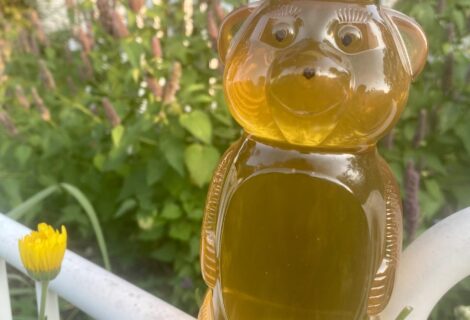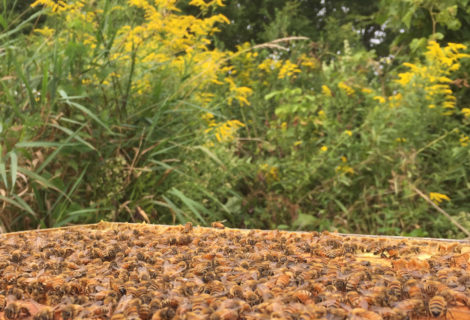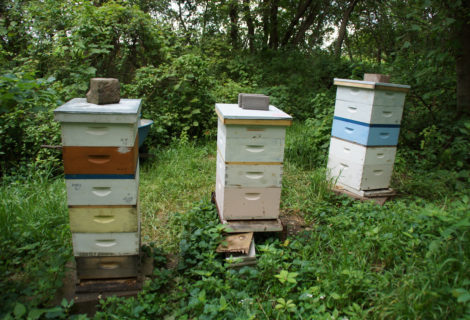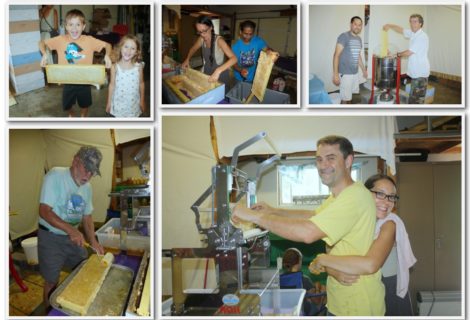Over-winter Colony Report
It’s been a long time since posting. When I’m at home, the kids manage to do a pretty good job of keeping me away from the computer. But it’s time to take stock of where things are at with the bees. In the 2015 season, we had 7 colonies – all new from packages or nucs. Two of the colonies were never very healthy and didn’t stay queen-right for long. Going into the fall, they had very few bees and I knew that we could not overwinter them. They did not re-queen and they petered out pretty quickly.
We went into winter with 5 colonies and we have come into April with three. The strongest of the 5 colonies was lost right away in December, and the other (also a strong fall colony) was lost in January. It did not appear to be mites or disease or lack of food. The following image is from January 30, when we took apart hive B. The remaining bees that had not fallen to the bottom board were in a cluster at the top of medium box #2 in a 4 box stack. Plenty of honey and sugar syrup were stored above. The bottom of the cluster shown here is around an old brood nest. You can see uncapped larvae and everything capped is pupae. The hanging bees are just the remains the cluster that have not fallen. The bees that that are head-first (abdomens-out) are in the classic starve-out position; however, this also the position that the “heater bees” for the brood nest would be in. The problem is that honey bees should not be maintaining a brood nest into winter, so is this an old nest that cluster just “happened” to move back to, or is something else going on here?
I’m going to post some separate articles about the different types of colony losses that we’ve had. So before I go into more details with that, here’s how the rest of winter went.
That same day – Jan 30 – turned out to be in the 30s, so we used two medium supers of frames with a good amount of honey/syrup from the hive that died out. We took thee supers and quickly placed them on the top frame box of the hive stacks of two of the living colonies. The bees were up at the top and were looking hungry. This gave them a whole other super to move into. The following picture is after that operation. Hive D now has a deep and 3 mediums, with the bramble box back on top. The north-most hive E has a deep and two mediums with the bramble box back on top.
My dad had pieces of roofing steel that we laid on over the telescoping cover to help keep the snow off the hive entrance. That worked well the rest of the winter. You can see that we’ve got the entrances blocked with an extra piece of wood because we’re doing quite a bit of activity and we’d rather keep the bees coming out to a minimum because it’s not flying weather and most of them would not make it back to the hive. The plastic that we had wrapped the hives in is also gone. That didn’t turn out to be the best idea. It provided a moisture barrier, but it would lock moisture droplets between the hive and the plastic and it did not really let the hives “breathe” very well. I suspect it may have contributed to at least one of the other hive loses. Even though we have the entrance at the bottom plus top entrance plus 4+ vent holes drilled in the bramble boxes, it seems like a little breathing is helpful in other areas of the hive as well. My dad took his plane up and snapped an aerial view of the area in February. This is looking west and the hives are on the east side of the woods pointed at by the arrow. The river runs at the very bottom of the picture, so they have a nice water source very close by.
We began feeding them some winter patty in February in the bramble/quilt boxes. We’ve had a significant number of warmer days this winter in the 30s and 40s. Much more than last winter. The bees definitely took advantage of them, even when honey bee biology says they shouldn’t be out-and-about so much. Sunshine on the hive always helps too.
We observed that the D & E hives were most active in February, and then slowed down in March. Hive C (the south-most) picked up its activity through March. At the bottom of the picture, you can see the bees have done their own housekeeping and pushed out their dead bees in front of the hive entrance. And this was the smallest hive by volume with 3 mediums. They certainly were humming strong right beneath the bramble box. On March 8, feeling a little bad about not providing them another super earlier, we were ready with an extra one to go on – again with the center frames full of honey/syrup.
The next photo is opening it up and looking top-down into the bramble box. It’s so warm, the winter patty has melted and they’ve kind of stopped eating the gooey mess. Prior to this, my dad had scrapped some comb & syrup off a frame in the barn and spread that mixture over the winter patty, and they seem to have lapped that stuff up right away. In the compartments with the wood chips, there is moisture dripping from the cover and being caught by the chips. This is typical of what we found in the other hives as well, so the chips are doing their job.
Underneath the bramble box, were several clustered groups of bees – many of them underneath the wood chips. These are Carniolan bees. Of the 3 surviving colonies, C & D had Carniolan queens, and E had Italian. We quickly put the new super on C, followed by the bramble box and bees again.
Unfortunately, the new super with frames of feed did not sit square. You can see the gap here was big enough the bees to get in and out of. Tried some re-positioning, but mainly had to tape it and put a lot of rocks on top to better close the gap.
Switched to some pollen patty chunks in March that I had left over from last year. Here you can see the little bit of pollen substitute debris left in the corners of the plastic mesh of another hive. These winter bees have thinned-down some and a few are able to push through the grid. Next year, we might have to go with something a little smaller.
On March 27 (Easter), we removed the quilt boxes, placed a part of pollen patty on the top box and then a top feeder over that with spring sugar syrup. Hive C (the strong one) has been consuming the syrup pretty much non stop, while the others are not really touching it. They also did not clear out their dead bees so on March 31, my dad temporarily took off the entrance reducer of those and swept out a good many of the dead bees on the bottom board. They were rotting there and beginning to smell of silage.
It’s unclear whether D & E are queen-right or have a cluster large enough to survive the cool days of April. I’m anxious for a warm day that works with my schedule to open them up and check out the brood nest, if there is one. If not, I’m at least hoping to split colony C later in April. They are amazing creatures, but it is always touch-and-go when it comes to colony survival in the 21st century.
















Recent Comments